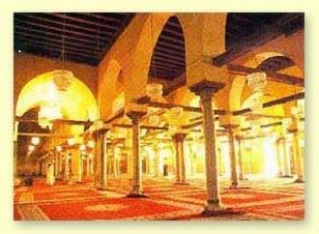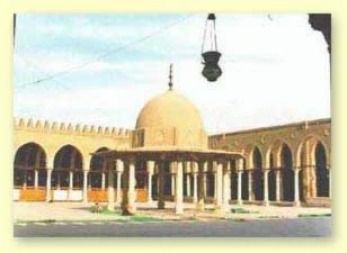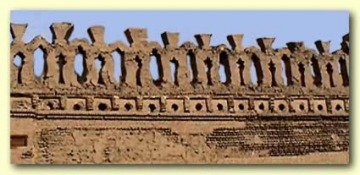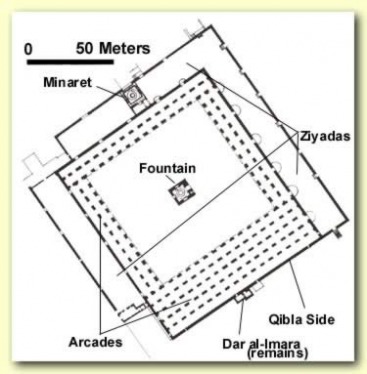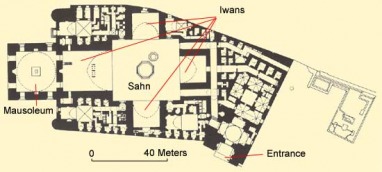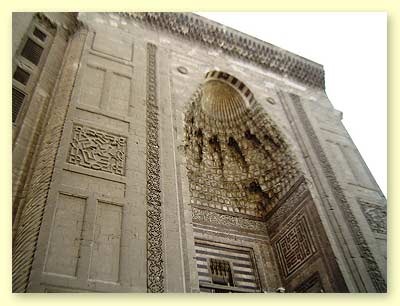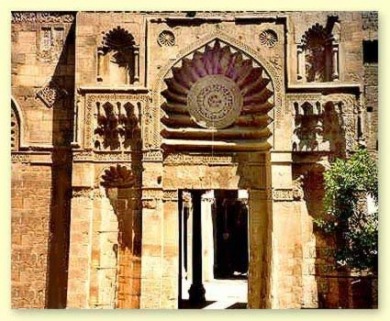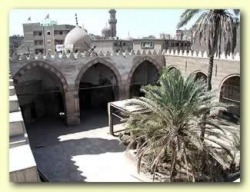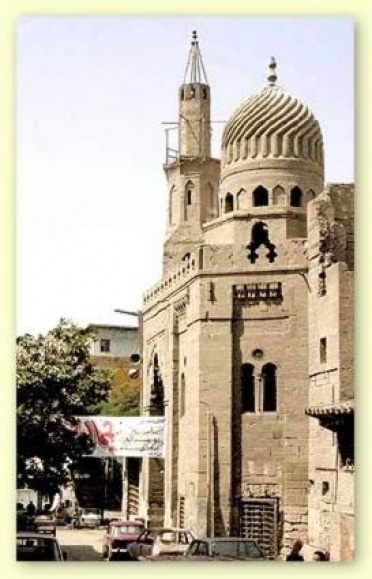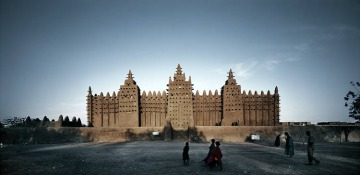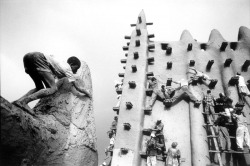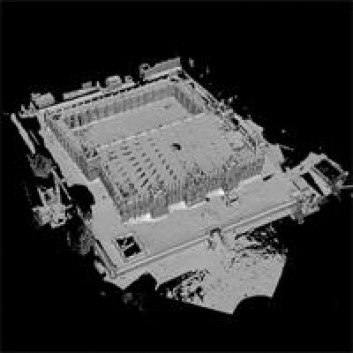Mosques of Africa
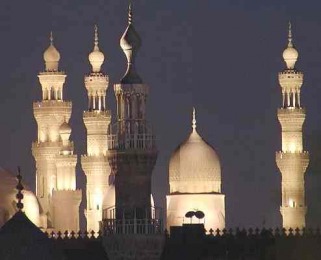
1. Egypt:
One of Cairo's many epitaphs is the "City of 1,000 Minarets". Actually, there are more than that, and so it should be no surprise that there are many historical mosques in Egypt, mostly in Cairo. Many western visitors to Egypt may initially have very little interest in seeing these medieval buildings, but on first sight, those with any interest in architecture will be awestruck by their beauty and design.
Because Egypt has seen many influences from any number of different ruling empires, including Abbasid, Fatimid, AyyubidMamluk and Ottoman and others, and because Cairo specifically is a city of the world, Egypt offers a fair overview of mosque styles. Furthermore, its mosques date from the earliest periods of Islam up to and of course, including modern varieties.
Egypt has some very notable, as well as important mosques, some of which may be visited while others are not open to touristic visits. While most of the tourist mosques are to be found in Islamic Cairo, the oldest of them all, the Amr Ibn El-Aas Mosque, is located in Coptic (Christian, or Old Cairo) and may be visited, while the Al-Azhar Mosque, the location of the World's oldest University and one of the most influential mosques in Islam, is not a tourist facility.
Some mosques in Egypt, and particularly Cairo, are actually complexes that include a number of other structures that may, or may not be found attached to other mosques. For example, many mosques include an Islamic school facility, called a madrasa. Others may have mausoleums and tombs, and even hospitals (maristan), along with other structures within the complex.
Mosques may be located in strange places. There is a mosque (Abu Al-Haggag Mosque), which creates a rather strange appearance inside the Temple of Luxor in Upper Egypt, and in the Sinai, a Fatimid mosque is incorporated into the famous St. Catherine's monastery.
While it is difficult to miss the many mosques in Egypt, as they are everywhere, those visiting the country should take at least a moment out of their busy itineraries to appreciate these grand monuments to Islam.
1.Amr Bin Alas:
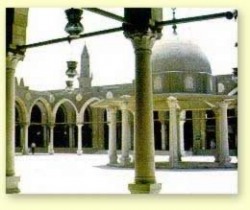
This is the first and oldest mosque ever built on the land of Egypt. Erected in 642 AD (21 AH) by Amr Ibn al'As, the commander of the Muslim army that conquered Egypt, the mosque is also known as Taj al-Jawamie (Crown of Mosques, al-Jamie'al-Ateeq (the Ancient Mosque) and Masjid Ahl ar-Rayah (Mosque of Banner Holders).
The mosque is said to have been built on the site of Amr Ibn el-As's tent at Fustat, is the oldest existing mosque, not just in Cairo, but the entire African Continent. Located north of the Roman Fortress of Babylon, it is actually on the edge of Fustat, the temporary city founded by Amr, and was an Islamic learning center long before El-Azhar Mosque. It could hold up to 5,000 students.
The mosque was originally built on an area of 1,500 square cubits, overlooking the Nile. The
initial structure was quite simple; with walls bare of any plaster or decorations, but without niche (miharb), minaret or ground cover. It had two doors on the north and two others facing Amr's house.
The mosque area remained unchanged until 672 AD (53 AH), when Musallama al-Ansari, Egypt's ruler on behalf of Caliph Mu'awiya Ibn abi-Sufian undertook expansion and renovation works for the mosque. Walls and ceilings were decorated and four compartments for "muezzins" (callers for prayers) were added at the corners, together with a minaret, while the mosque ground was covered with straw mats.
In 698 AD (79 AH), the mosque was demolished and expanded by Abdul-Aziz Ibn Marwan, Egypt's ruler. Once again in 711 AD (93 AH), the mosque was demolished by Prince Qurrah Ibn Shuraik al-Absi, Egypt's ruler. Upon the orders of Caliph al-Waleed Ibn Abdul-Malek, the mosque area was enlarged, a niche, a wooden pulpit (minbar) and a compartment and copings of four cloumns facing the niche were gold-coated. The mosque had then four doors to the east, four to the west and three to the north.
Under the Abbasid state, successive additions and repairs were introduced. In 827 AD (212 AH), Abdullah Ibn Taher, Egypt's ruler on behalf of Caliph al-Ma'moun ordered an equivalent area to the north to be added to the mosque, thus bringing its total area to its present level of 13,556,25 square metres. (112.3m x 120.5m). However, the Fatimid period was the gold era for the mosque, where gilted mosaics, marble works, a wooden compartment and a moving pulpit were introduced and part of the niche was silver-coated.
The last structural amendments in Amr Mosque were made during the rule of Murad Bey under the ottoman era, in 1797 AD (1212 AD). Because of the collapse of some columns, the interior of the mosque was demolished and rebuilt. As a result, eastern arcades were repositioned so as to be perpendicular to the mihrab wall. Accordingly, arches were extended across windows. Two minarets were built and are still extant.
Amr Mosque was not merely a place of worship but also served as a court for settling religious and civil disputes. Moreover, teaching circles were organized either for general religious preaching or teaching lessons in Quranic sciences, jurisprudence and Prophet Muhammad's Tradition (Hadith) as well as letters.
The mosque incorporates elements of Greek and Roman buildings, and has 150 white marble columns and three minarets. Simple in design, its present plan consists of an open sahn (court) surrounded by four riwaqs, the largest being the Qiblah riwaq. There are a number of wooden plaques bearing Byzantine carvings of leaves, and a partially enclosed column is believed to have been miraculously transported from Mecca on the orders of Mohammed himself. There are many other ancient legions related to the Mosque.
2.The Mosque of Ahmad ibn Tulun
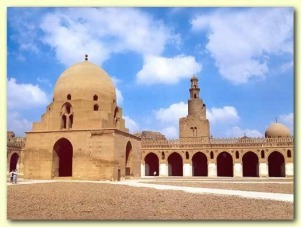
The Ibn TulunMosque was completed in 879 AD on Mount Yashkur in a settlement named al-Qata'i by the founder of Egypt's Tulunid Dynasty (868-905 AD), Ahmad ibn Tulun. Al-Qata'i was about two kilometers from the old community of Fustat. He was born in Baghdad, the son of a Turkish slave of Mongol origin owned by the Caliph, al-Ma'mun. He would later rise to became governor of Egypt after his stepfather, who died in 870, was awarded that position.
The mosque that he had built over a period of three years of mudbrick became the focal point of the Tulunid capital that lasted only 26 years. It was the third congregational mosque to be built in what is now greater Cairo, and at approximately 26,318 square meters in size, is the third largest mosque in the world. It is the oldest mosque in Egypt that has survived in a fairly original form. An ancient calligraphy in 9th century Kufic script provides:
"The Amir... has ordered the construction of this blessed and happy mosque, using the revenues from a pure and legitimate source that God has granted him..''
3.sultan Hasan:
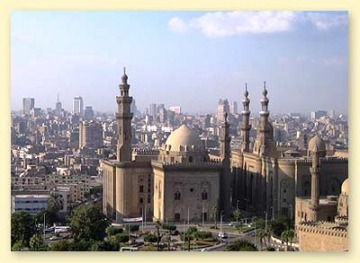
The Medresa of Sultan Hassan at Cairo...is a collegiate mosque, cruciform in plan. Four iwans, or recessed porches, with immense pointed arches, constitute the arms of the cross. There is a minimum of decoration, and the walls of the 100-ft sahn rise skywards with splendid
architectural effect. The founder's domed mausoleum, situated behind the qibla, is enriched with stalactite decoration."
The founder of this gigantic monument was Sultan Hassan, the son of the great Mamluk Sultan, Al Nasser Mohamed Ibn (son of) Qalawoun. Sultan Hassan actually ruled Egypt twice. The first time was in 1347 when he was only 13 years old, but he was dethroned by the other Mamluk princes and generals. His second rule of Egypt began in 1356 and lasted until 1361. He was not a glorious and impressive sultan, but more of a puppet manipulated by powerful amirs, such as Amir Sarghatmish.
Other mosques in Egypt:
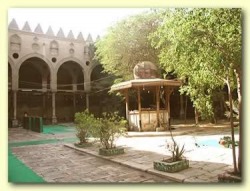
Altunbugha al-Maridani Mosque
El-Aqmar Mosque (Gray Mosque)
The Aqsunqur Mosque (The Blue
The Mosque of Aytmush (Aytmishi) al-Bagassi in Cairo
2.North Africa:
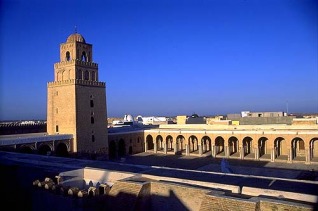
The great mosque of Qairouan
From the 11th century onward, however, Kairouan ceased to be the capital of Arab Ifriqiya. Tunis, Tlemcen, Fez, Marrakech and other North African cities usurped its political and economic prominence. Slowly the ancient city shrunk in size until it covered scarcely a third of the area occupied by the metropolis of the Aghlabids, the Fatamids, and the Zirids. Yet, as a holy city, Kairouan grew in importance with the passing centuries and its splendid mosque became a magnet for pilgrims from Muslim territories throughout Northern and Saharan Africa.
The Great Mosque, also known as the Sidi Oqba mosque, had its simple beginnings in 670 AD, during the time of Uqba ibn Nafi, the original founder of Kairouan. As the city expanded during the following three hundred years, the original mosque was torn down and rebuilt in 703, again in 774, and then significantly enlarged by rulers of the Aghlabid dynasty in 836 and 863. By the end of the 9th century the mosque had attained the size and proportions that it exhibits today, though numerous renovations and ornamentations were conducted during the 13th and 14th centuries by the Hafsid dynasty rulers and during the 17th, 18th and 19th centuries (when the region was controlled by the Turks) by the Mouradite and Husseinite rulers.
The Great Mosque of Kairouan takes the general form of a rectangle with sides of 242, 229, 410 and 406 feet. This enormous space contains a prayer hall, a courtyard and a soaring minaret. Surrounding this sacred area is an enclosing wall reinforced by projecting buttresses and two stone towers and pierced by nine doorways. The marble-paved courtyard is flanked by three porticoes made up of long naves whose roofs are supported by arches. These arches are in turn supported by dozens of lovely marble columns which various Arab rulers and builders removed from more ancient Roman and Byzantine sites. The minaret is three stories tall, 103 feet high by 34 feet wide, with its lower stories composed of stone blocks taken from classical Roman buildings. This minaret, built from 724 to 728 AD, is the oldest standing minaret in the world and is widely recognized as one of the greatest gems of Islamic architecture. The prayer hall, built in the 9th century, is 123 feet deep and 230 feet wide.
Commenting on the interior of the Prayer Hall, the Islamic historian Paul Sebag (The Great Mosque of Kairouan) says: "It is decorated with extreme richness. All of the resources of Islamic ornamentation, carved or painted, have been lavished here on marble, stone, pottery, or wood. This ornamentation borrows its elements from the vegetable world, from geometry, and from epigraphy. Its flora inherited from the Hellenistic tradition the acanthus, the vine, and even the palm tree; it was enriched by oriental plants such as the lotus and the homa, but above all it evolved an imaginary and idealized plant world made up of rinceaux and tresses, of palmettes and fleruons, all of extreme elegance and grace. The geometrical ornamentation of pagans, Christians, and Berbers was extended and refined before being used for the creation of surprising and strange new figures. Arabic writing lends itself here to the fantasy of the calligrapher and reveals its incomparable qualities as decoration. These elements are juxtaposed and mingled to compose a decor which is enchanting......Moving forward with slow steps through the half-light in which the sanctuary swims, we suddenly find that the stones, when ordered by an inspired mind, can attain to sublime poetry and move us profoundly."
Other Mosques of North Africa:
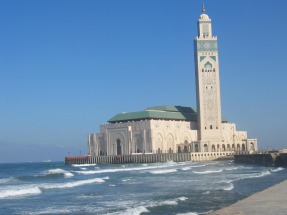
The Great Mosque of Taza (Jamaa El-Kbir) is the most prominent building in the medina of Taza, not far from the Bab er-Rih ("Gate of the winds"). It was built by the Almohad sultan Abd al-Mu'min in the period after 1142. According to the Kitab el Istibsar the walls were completed in 1172. The mosque was enlarged during the reign of the Marinid dynasty in 1292-1293.
The Hassan II Mosque (Arabic مسجد الحسن الثاني) is a mosque located in Casablanca, Morocco. Designed by the FrencharchitectMichel Pinseau, it is the second largest in the world (after the Masjid al-Haram in Mecca). It stands on a promontory looking out to the Atlantic, which can be seen through a gigantic glass floor with room for 25,000 worshippers. A further 80,000 can be accommodated in the mosque's courtyard. Its minaret is the world's tallest at 210 metres (689 ft).
The Koutoubia Mosque (Arabic: جامع الكتبية) is the largest mosque in Marrakech, Morocco. The minaret was completed under the reign of the AlmohadCaliphYaqub al-Mansur (1184-1199) and was used as model for Giralda of Seville then for the Hassan Tower of Rabat.
The name is derived from the Arabic al-Koutoubiyyin for librarian, since it used to be surrounded by sellers of manuscripts. It is considered the ultimate structure of its kind. The tower is 69 m (221 ft) in height and has a lateral length of 12.8 m (41 ft). Six rooms (one above the other) constitute the interior; leading around them is a ramp by way of which the muezzin could ride up to the balcony. It is built in a traditional Almohad style and the tower is adorned with four copper globes.
According to legend, they were originally made of pure gold, and there were once supposed to have been only three. The fourth was donated by the wife of Yacoub el-Mansour as compensation for her failure to keep the fast for one day during the month of Ramadan. She had her golden jewelry melted down to fashion the fourth globe.
The minaret of the Koutoubia has stood the model for the minaret of the Giralda mosque in Sevilla which in its turn has stood model for thousands of church towers in Spain and East Europa (e.g. the churches on the red square in Moscow), and later for many buildings throughout the United States (e.g. the municipal buiding) and Russia (especially during the Stalinist era).
The mosque of Mulai Idris is one of the earliest mosques in the history of Morocco. It was built by the founder of Fes about the year 810.
The sanctity of the shrine in particular is esteemed very great, and this accounts flock to it. The Tumiat door leading to it was once very fine, but is now much faded. Opposite to it is a refuge for friend-less sharifas—the female descendants of Muhammad—built by Mohammed XVII. It is believed that the foundation stone of Fez was laid in 808 by Idris II. Since then its history has been chequered, as it was successfully besieged no fewer than eight times in the first five hundred years of its existence, yet only once knew foreign masters, when in 1554 the Turks took possession of it without a siege and held it for a short time. Fez became the chief residence of the Filali dynasty, who obtained possession of the town in 1649. The population has been very varyingly estimated; probably the inhabitants number under one hundred thousand, even when the court is in residence.
The Tin Mal Mosque is a mosque located in the High Atlas mountains of North Africa. It was built in 1156 to commemorate the founder of the Almohad dynasty, Mohamed Ibn Tumart. It is one of the two mosques in Morocco open to non-Muslims, the other being the Hassan II Mosque in Casablanca. The mosque has the same lay-out as the (Almohad) Koutoubia in Marrakesh.
University of Al-Karaouine: The University of Al-Karaouine is part of a mosque, founded in 859 by Fatima Al-Fihri, the daughter of a wealthy merchant named Mohammed Al-Fihri. The Al-Fihri family had migrated from Kairouan (hence the name of the university), Tunisia to Fes in the early 9th century, joining a community of other migrants from Kairouan who had settled in a western district of the city. Fatima and her sister Mariam, both of whom were well educated, inherited a large amount of money from their father. Fatima vowed to spend her entire inheritance on the construction of a mosque suitable for her community.
Famouse mosques of Africa:
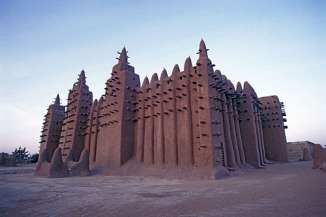
The mosque at Yaama, Niger(1962, with additions 1978-82)
An intricate system of wooden ribbing covered with mud plaster is used.
The mosque at Pana,Mali(rebuilt in the 1960's.
The mosque of Said bi Sultan at Mtoni, Zanzibar(1840).
The Riadha Mosque, Kenya (1902-3)
Its style shows a clear evidence of influences brought to the east coast of Africa by settlers of Indian origin.
DjinguereBer Mosque, Timbuktu(Fourteenth Century)
Minaret, Songhay period.
The Mosque of Djenne, Mali
Djenné, the oldest known city in sub-Saharan Africa is situated on the floodlands of the Niger and Bani rivers, 354 kilometers (220 miles) southwest of Timbuktu. Founded by merchants around 800 AD (near the site of an older city dating from 250BC), Djenné flourished as a meeting place for traders from the deserts of Sudan and the tropical forests of Guinea. Captured by the Songhai emperor Sonni 'Ali in 1468, it developed into Mali's most important trading center during the 16th century. The city thrived because of its direct connection by river with Timbuktu and from its situation at the head of trade routes leading to gold and salt mines. Between 1591 and 1780, Djenné was controlled by Moroccan kings and during these years its markets further expanded, featuring products from throughout the vast regions of North and Central Africa. In 1861 the city was conquered by the Tukulor emperor al-Hajj 'Umar and was then occupied by the French in 1893. Thereafter, its commercial functions were taken over by the town of Mopti, which is situated at the confluence of the Niger and Bani rivers, 90 kilometers to the northeast. Djenné is now an agricultural trade center, of diminished importance, with several beautiful examples of Muslim architecture, including its Great Mosque.
In addition to its commercial importance, Djenné, was also known as a center of Islamic learning and pilgrimage, attracting students and pilgrims from all over West Africa. Its Great Mosque dominates the large market square of Djenné. Tradition has it that the first mosque was built in 1240 by the sultan Koi Kunboro, who converted to Islam and turned his palace into a mosque. Very little is known about the appearance of the first mosque, but it was considered too sumptuous by Sheikh Amadou, the ruler of Djenné in the early nineteenth century. The Sheikh built a second mosque in the 1830's and allowed the first one to fall into disrepair. The present mosque, begun in 1906 and completed in 1907, was designed by the architect Ismaila Traoré, head of Djenné's guild of masons. At the time, Mali was controlled by the French, who may have offered some financial and political support for the construction of the mosque and a nearby religious school.
The Great Mosque is built on a raised plinth platform of rectangular sun-dried mud bricks that are held together by mud mortar and plastered over with mud. The walls vary in thickness between sixteen and twenty-four inches, depending upon their height. These massive walls are necessary in order to bear the weight of the tall structure and also provide insulation from the sun's heat. During the day, the walls gradually warm up from the outside; at night, they cool down again. This helps the interior of the mosque to stay cool all day long. The Great Mosque also has roof vents with ceramic caps. These caps, made by the town's women, can be removed at night to ventilate the interior spaces.
